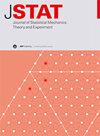Local detailed balance for active particle models
IF 1.9
3区 物理与天体物理
Q2 MECHANICS
Journal of Statistical Mechanics: Theory and Experiment
Pub Date : 2024-06-25
DOI:10.1088/1742-5468/ad5435
引用次数: 0
Abstract
Starting from a Huxley-type model for an agitated vibrational mode, we propose an embedding of standard active particle models in terms of two-temperature processes. One temperature refers to an ambient thermal bath, and the other temperature effectively describes ‘hot spots,’ i.e. systems with few degrees of freedom showing important population homogenization or even inversion of energy levels as a result of activation. That setup admits to quantitatively specifying the resulting nonequilibrium driving, rendering local detailed balance to active particle models, and making easy contact with thermodynamic features. In addition, we observe that the shape transition in the steady low-temperature behavior of run-and-tumble particles (with the interesting emergence of edge states at high persistence) is stable and occurs for all temperature differences, including close to equilibrium.主动粒子模型的局部详细平衡
我们从赫胥黎式搅拌振动模式模型出发,提出了用双温过程嵌入标准活性粒子模型的方法。其中一个温度指的是环境热浴,而另一个温度则有效地描述了 "热点",即自由度较小的系统,由于活化而出现重要的种群同质化甚至能级反转。这种设置可以定量地说明由此产生的非平衡驱动力,为活性粒子模型提供局部的详细平衡,并方便地与热力学特征相联系。此外,我们还观察到,在所有温差条件下,包括接近平衡时,翻滚粒子的稳定低温行为(在高持久性条件下出现有趣的边缘态)中的形状转变是稳定的。
本文章由计算机程序翻译,如有差异,请以英文原文为准。
求助全文
约1分钟内获得全文
求助全文
来源期刊
CiteScore
4.50
自引率
12.50%
发文量
210
审稿时长
1.0 months
期刊介绍:
JSTAT is targeted to a broad community interested in different aspects of statistical physics, which are roughly defined by the fields represented in the conferences called ''Statistical Physics''. Submissions from experimentalists working on all the topics which have some ''connection to statistical physics are also strongly encouraged.
The journal covers different topics which correspond to the following keyword sections.
1. Quantum statistical physics, condensed matter, integrable systems
Scientific Directors: Eduardo Fradkin and Giuseppe Mussardo
2. Classical statistical mechanics, equilibrium and non-equilibrium
Scientific Directors: David Mukamel, Matteo Marsili and Giuseppe Mussardo
3. Disordered systems, classical and quantum
Scientific Directors: Eduardo Fradkin and Riccardo Zecchina
4. Interdisciplinary statistical mechanics
Scientific Directors: Matteo Marsili and Riccardo Zecchina
5. Biological modelling and information
Scientific Directors: Matteo Marsili, William Bialek and Riccardo Zecchina

 求助内容:
求助内容: 应助结果提醒方式:
应助结果提醒方式:


